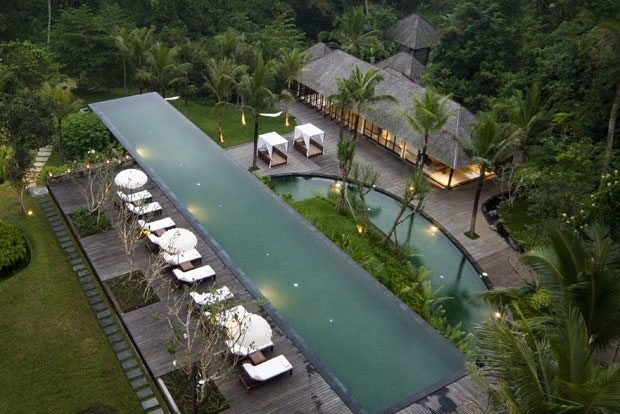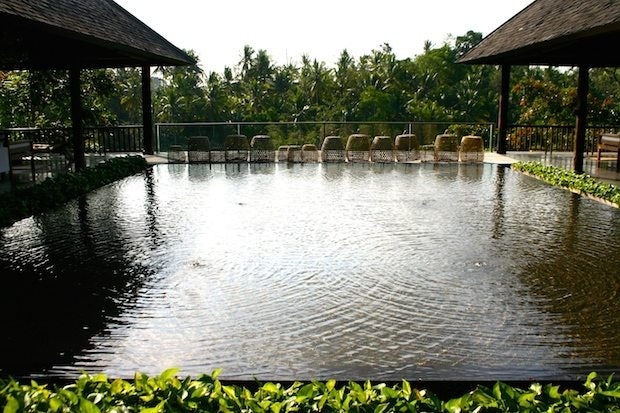
Komaneka Resorts in Ubud, Bali has seen significant growth in Chinese visitor numbers. (Courtesy Photo)
A guided group tour centered around major sites and shopping has long been considered to be the main purview of Chinese tourists abroad, but that mindset is changing quickly for many of China’s luxury travelers on the tropical island of Bali.
Tourism is booming on the Indonesian island thanks in large part to Chinese tourists, which make up Bali’s second-largest group of visitors after Australians. Its heavily developed, tourist-heavy beachfront areas of Kuta, Legian, and Seminyak boast an array of duty-free luxury shopping options and resorts built by the world’s top hotel conglomerates. These attractions have no doubt seen big benefits from the stunning 45 percent year-on-year growth in Bali’s number of Chinese visitors in the first seven months of 2014 for a total of 330,172. By the end of the year, these numbers will almost certainly surpass 2013’s total of 387,533 Chinese visitors and 24 percent year-on-year increase.
But travel inland toward the hills of Bali’s artsy Ubud District, an area filled with rice paddies and coconut groves often referred to as the “soul of Bali,” and another very distinct side of the Chinese travel revolution emerges. Instead of tourist-filled beaches, shopping for Gucci and Chanel, and staying at major hotel chains, the main attractions here are cultural activities, idyllic natural scenery, and locally run accommodations. According to local businesses, Chinese travelers hoping for unique, experiential travel are flocking to the area.
One luxury hospitality provider on the front lines of this evolution is Komaneka Resorts, an award-winning collection of four locations founded by a local Balinese couple born and raised in Ubud. The resorts combine top-notch amenities and service (including fresh local fruit and a flower-filled bathtub on arrival) with local Balinese architecture and aesthetics as well as artwork by local artists. The resort’s Bisma location is designed and decorated in the style of a traditional Balinese home, and overlooks both a luxe infinity pool and fully functioning rice paddy. A total of 45 percent of the resorts’ guests are Chinese, a portion much higher than the 15 percent of the total number of tourists to Bali that Chinese visitors currently comprise.

Komaneka's resort at Bisma features traditional Balinese elements. (Jing Daily)
Chinese tourists’ favorite activity in Ubud is—unsurprisingly—shopping, says Komaneka Public Relations Manager Ika Dewi. The area has not, however, seen an influx of high-end global luxury brands like its neighbors on the shore. Rather, the goods available in Ubud include handicrafts, locally grown products such as coffee and spices, and textiles, which Chinese buyers see as authentic, unique gifts to bring home to friends and relatives.
Chinese tourists’ interests span far beyond shopping when they visit. “Most of the Chinese guests are not only coming for shopping. They’re willing to learn about our culture,” says Dewi. According to her, traditional Balinese dance classes offered by the resort are more popular with Chinese visitors than with any other group of guests, and Chinese visitors’ top interests also include whitewater rafting and watching dance performances. They’re also enthusiastic about Komaneka’s cultural classes in sculpture, wood carving, making offerings, painting, cooking, and wearing traditional attire. According to Dewi, “If they come to Ubud, they are looking for culture.”
As the number of outbound Chinese tourists skyrockets, businesses across the world have been studying their travel habits and demands. A total of 54 million mainland Chinese visitors have traveled abroad in the first half of 2014, according to the China Outbound Tourism Research Institute. This puts the number on track to surpass the 97 million that traveled overseas in 2013 by the conclusion of 2014. The China Tourism Academy predicts that they will have spent $155 billion abroad by the end of this year, marking a year-on-year growth rate of 20 percent growth from 2013.
While shopping-oriented group travel is a major part of this growth, the popularity of a hospitality brand such as Komaneka among Chinese travelers highlights the fact that many experienced Chinese travelers are opting for individual travel and distinctive local experiences. Frequently featured in Chinese lifestyle media, the resort has seen about 40 percent growth in the number of its Chinese guests over the past year.
It also offers Chinese-language menus at its restaurant, where Dewi says that local food is in high demand among its Chinese guests. “If they come to Ubud, they [Chinese visitors] want to enjoy the Indonesian food. The most popular is suckling pig,” she says, referring to a local Balinese specialty. She states that a local roast duck dish is also extremely popular with Chinese tourists.

Chinese tourists snap photos at the Ubud Palace in Ubud, Bali. (Jing Daily)
The shifting preferences taking place in Bali support recent research that Chinese tourists’ demands for experiential luxury travel is growing as experts declare that the time of the “100 percent shopping trip” is over. A Hotels.com survey published in July this year stated that 71 percent of all Chinese tourists now travel independently rather than with a group, and 77 percent do so in Asia. Meanwhile, a Boston Consulting Group survey published in February this year found that 29 percent of Chinese luxury consumers prefer to spend on “enriching experiences” over products, while a Hurun Report survey of affluent Chinese travelers published in June found that adventure excursions are gaining in popularity.
These changing tastes are having a global effect on the way both hoteliers and retailers cater to Chinese tourists. While resorts in unique locations have ample opportunity to take advantage of the trend, luxury brands have also been coming up with creative in-store experiences in China and across the world such as special events and product customization. LVMH-owned DFS, which has locations in Bali and across the Pacific Rim, teams up with luxury brands to provide limited-edition items available only in a given location. Although China's tourism numbers mean massive growth, the businesses set to gain are the ones staying on top of what Chinese travelers want.